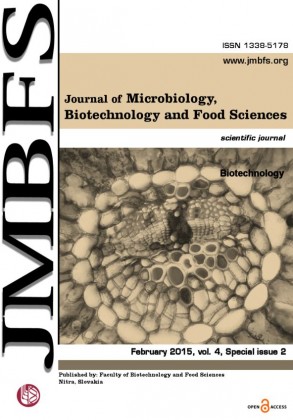COMPARISON OF 2-DE PROTEOME MAPS OF WHEAT, RYE AND AMARANTH
DOI:
https://doi.org/10.15414/jmbfs.2015.4.special2.7-10Keywords:
Amaranth, buckwheat, 2-DE protein maps, celiac diseaseAbstract
The protein maps of wheat (Triticum aestivum L.), cv. Brea; rye (Secale cereale L.), cv. Oklon and amaranth (Amaranthus sp.) cv. Plaisman were obtained by performing 2-DE over a broad pH range (pH 3-11NL) to obtain total protein profiles. Focussing on the gluten fraction, as it is the major trigger for Celiac disease, proteins were separated with a basic pI over a narrow pH range of pH 6-11. Putative identifications of proteins were determined using current literature. The overall spot pattern from wheat over pH 6-11was identified as gamma-gliadins (~ pI 8-10, Mrs 28 - 30, 000 Da), alpha/beta-gliadins (~pI 6.5-7.5, Mrs 25 - 35, 000 Da) and gluten proteins (pI 6-10, Mrs 35 - 60, 000 Da.). The rye had a higher number of abundant groups visible over a broad range (~ 6-200,000 Da, pI 4-9). Comparison of rye to wheat protein maps showed that each cereal had completely different spot patterns in the LMW region of the gels (<14,000 Da), but similarities were observed in the HMW and MMW regions. This is especially evident in the pH 6-11 gels. Amaranth has many proteins focussed between pH 3-11. Fewer proteins were observed for the pH 6-11 gel, especially in the HMW weight region of the gel. This is due to the fact that the pseudocereals are a botanically different species compared to cereal grasses, and even if they are rich in protein, unfavourable fractions are not present or are only available in small amounts.Downloads
Download data is not yet available.
Downloads
Published
2015-02-02
How to Cite
Gálová, Z., PálenÄárová, E., Chňapek, M., & Balažová, Želmira. (2015). COMPARISON OF 2-DE PROTEOME MAPS OF WHEAT, RYE AND AMARANTH . Journal of Microbiology, Biotechnology and Food Sciences, 4(special issue 2 (Biotechnology), 7–10. https://doi.org/10.15414/jmbfs.2015.4.special2.7-10
Issue
Section
Biotechnology
License
Copyright (c) 2015 Zdenka Gálová, Eva PálenÄárová, Milan Chňapek, Želmira Balažová

This work is licensed under a Creative Commons Attribution 4.0 International License.
All papers published in the Journal of Microbiology, Biotechnology and Food Sciences are published under a CC-BY licence (CC-BY 4.0). Published materials can be shared (copy and redistribute the material in any medium or format) and adapted (remix, transform, and build upon the material for any purpose, even commercially) with specifying the author(s).





